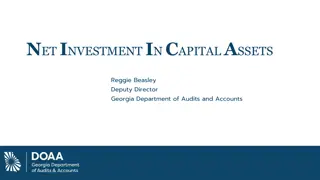The Next Safety Net: Anchor Institutions and the Peak State in the UK
A discussion on the concept of the Peak State in the UK, highlighting challenges in government funding and rising demand for health and social care services. It explores the role of anchor institutions in addressing these issues and discusses the potential impacts of austerity measures on local authorities.
Download Presentation

Please find below an Image/Link to download the presentation.
The content on the website is provided AS IS for your information and personal use only. It may not be sold, licensed, or shared on other websites without obtaining consent from the author. Download presentation by click this link. If you encounter any issues during the download, it is possible that the publisher has removed the file from their server.
E N D
Presentation Transcript
The Next Safety net? - Anchor Institutions and the end of the Peak State Barbara Colledge and Paul Hayes Leeds Beckett University
Austerity as inevitability: The Peak State represents the zenith of government s role in British national life. The idea is based on that of peak oil, which is not the point we run out of fossil fuels, but the point at which we pass our maximum ability to extract them from the ground. The fuel the government runs on is taxation. This is a renewable resource, but, even so, there is plenty of evidence to suggest that the state that the state will increasingly struggle to raise very high levels of it. Even if it could, the money would be quickly soaked up by ever-rising demand for health and social care services, leaving everything else in a state a crisis. (Parker 2015, p 124)
Budgets and duties Upper tier English local authorities still have over 3,000 statutory duties to deliver Energies and internal capacity of local authorities increasingly becoming into economic growth through city deals and devolution are also directed 56% Councils less confident that they will reach a balanced budget and be able to continue to deliver services for the next financial year (CIPFA, 2016) of finance directors in
Peak State or Peak Care? Around 70% of all upper tier local spending in England is on adult care and children s services, with less than 30% being spent on all other services authority Graphs forecasts rising demand and service collapse of Doom
Deconstructing the Peak State Narrative Peak State proves demand will inexorably rise and state will not be able to find resources to meet demand. Newman (2013) argues response to austerity has mediating processes neoliberalisation at a local level been councils of Local extend their own reach through new governmentalities and forms of expertise while seeking to displace the contradictions including those politics onto their partners as well as onto local citizens. government Seeking to they of face austerity
A Response to Peak State: Anchor Institutions http://community-wealth.org/sites/clone.community-wealth.org/files/styles/adaptive/public/Vision2010.png?itok=BHVoTt7m Concept developed in US Institutions anchored in a place Can be public, private or 3rd sector Can be large ( Eds and Meds ) or neighbourhood based [http://community-wealth.org/content/anchor-mission- leveraging-power-anchor-institutions-build-community- wealth]
Anchor Institutions Concept and Opportunities Community Wealth Building: A systems approach to economic development that creates an inclusive, sustainable economy built on locally rooted and broadly held ownership. This framework for development calls for developing place- based assets of many kinds, working collaboratively, tapping large sources of demand, and fostering economic institutions and ecosystems of support for enterprises rooted in community. The aim is to create a new system that enables inclusive enterprises and communities to thrive and helps families increase economic security. (Kelly, McKinley and Duncan, 2016, p 56). http://www.garalperovitz.com/2012/06/the-cleveland- model-2/
Rebalancing Government and Governance mechanisms through Anchor Institutions o Devolution policies create an increasing transfer of responsibility and accountability for local decision-making to city- regions. o Recognition that social issues and local institutions are complex networks -can these be harnessed? o Creating shared value and embedding shared social value across institutions different roles of organisations and individuals? o Rebalancing of roles and responsibilities of actors, institutions and organisations. o Shared risks, approaches/ processes e.g. procurement, recruitment, good employment. o New dimensions of austerity, roll back of welfare state, risk, and inequality reflected at local level. o Enables dialogue,local action and supports steerage of complex networks a shared arena for dialogue.
Maximising Value of Anchors Urban Design Investment Magnet Local Purchasing impact on economy and jobs Economic, Social & Environmental Impact Real Estate Developer Purchaser Poverty Alleviation University: Graduates Skills Innovation Enterprise Research Business Support Living Wage Core service or product Employer Skills and workforce Community Workforce Developer Capacity Builder Developing community capacity and clusters Cluster Anchor Source: ICIC 2010
Potential for Leeds City Region Leeds City region - 62.4bn GVA 3m population 17% of neighbourhoods in 10% most deprived in England Employment in service sector (O-Q) 2014 28% of employee jobs
Leeds City Region Anchors Significant Scale and Reliance - Public Services Number of anchors exceed 100 institutions and 300,000 jobs Anchor institutions turnover in LCR : 13.5 Billion (HEIs, FECs, Health, Housing Associations, Fire, Police) 9 HEIS, 40,000 graduates; 14 FECs. Employment AIs LCR 227,700 jobs - 20% of employee jobs in Leeds City Region Distribution varies Barnsley 16% Bradford 18% Calderdale 19% Craven 2% Harrogate 22% Kirklees 17% Leeds 16% Selby 32% Wakefield 40% York 20% Procurement/External Spend: Yorkshire and Humber LA combined external spend is 4.5 Billion Y&H: HEIs- 32.2 Billion output; 94,430 students; 63,000 jobs; 3.2B GVA; 2.2B indirect GVA ( 2.1 in region); 55,000 Yorkshire
LCR Strategic Economic Plan 2016-2036 Recent Partnership THE 11 LOCAL AUTHORITIES THAT COMPRISE LEEDS CITY REGION (BARNSLEY, BRADFORD, CALDERDALE, CRAVEN, HARROGATE, KIRKLEES, LEEDS, SELBY, WAKEFIELD AND YORK, ALONGSIDE NORTH YORKSHIRE COUNTY COUNCIL) HAVE BEEN WORKING IN PARTNERSHIP TO IMPROVE THE ECONOMY SINCE 2004. The LEP and the Combined Authority are now working as one to drive economic success. IMPACT The City Region has 15% more businesses than in 2011, a rise that outstrips national performance, and has attracted 31 inward investments, helping to raise foreign investment in Yorkshire by 145%. Skills programmes have created 2,350 new apprenticeships for young people and enabled 2,700 more young people to enter employment, education or training. There have been significant reductions in carbon emissions, energy improvements to over 1,000 properties, and major progress on developing an ambitious pipeline of new district heat networks. pp 16-17
LCR Strategic Economic Plan 2016-2036 Future? Partnership? PARTNERSHIP IMPLEMENTATION / BUSINESS PLANS e.g. The LEP and the Combined Authority / Local Authorities / Businesses / Universities and colleges / Voluntary and community organisations / Other agencies, e.g. Home and Communities, Highways England, Health, Environment Agency and others p 25
LCR Anchor Institutions Potential Economy, Employment, Skills Ladder Through direct and indirect impact; growth and innovation; Good growth and employment; procurement e.g. 1% increase in local spend = 400M (LAs only). Graduates. Education connected partnerships at all levels Health, Social, Welfare and Public Services Third sector and community; Shared services responses; Disposal of land/property? GAP? How to link and engage in sustainable way risks? Partnerships ? LCR- Strategic Economic Plan Partnership Implementation AIs Community Partnerships; collaborative/co-creation models
Examples of Local Initiatives Community Anchor Strategy: development of strategies to utilise community anchors for social development - Wakefield District Council and Calderdale County Council. Good growth strategies: Leeds City Region strategy and local authority initiatives such as Wakefield s good growth strategy. Living/fair wage pledges: Fostered through city compact in Leeds and the private sector in Wakefield. Shared principles: The Wakefield District Compact is a framework agreed between public sector, voluntary and community organisations with shared principles, objectives and for mutual benefit. Partnership Boards and Groups: The Wakefield Together Partnership and Local Services Board brings together key anchor institutions to work on collaborative solutions to the district s challenges and strategic priorities. The Wakefield Enterprise Partnership brings together business and public agencies to stimulate investment and economic growth. Leeds City Region Strategic Economic Plan 2016-2036 VISION TO BE A GLOBALLY RECOGNISED ECONOMY WHERE GOOD GROWTH DELIVERS HIGH LEVELS OF PROSPERITY, JOBS AND QUALITY OF LIFE FOR EVERYONE [LCR LEP (2016) Leeds City Region Strategic Economic Plan 2016- 2036, p58]
Conclusions Anchor institutions add to local toolkit for meeting challenges of austerity. Recognises private and 3rd sector contributions to social and economic issues But will this meet the scale of the challenge? Local wins but scale challenging without private sector engagement? The options and tools available for greater intervention by Anchors may be insufficient and slow to impact. Challenges in areas of deprivation or in health, community safety or cohesion, will require new types of intervention to address the scale and urgency of the task.
Contact Details Barbara Colledge Leeds Beckett University b.colledge@leedsbeckett.ac.uk Paul Hayes Leeds Business School, Leeds Beckett University/Wakefield Council phayes@wakefield.gov.uk


























